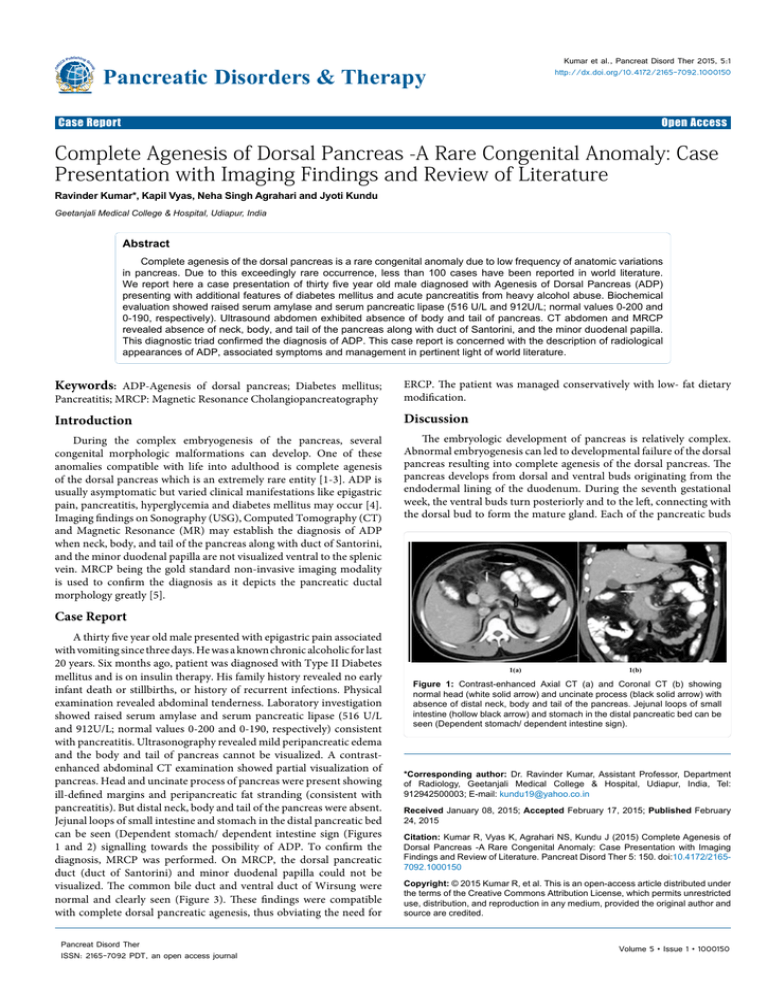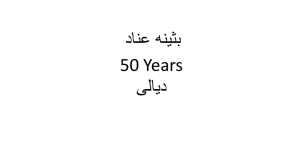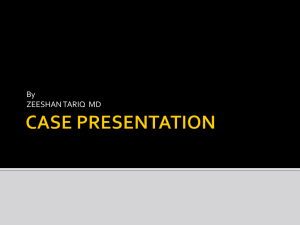advertisement

Kumar et al., Pancreat Disord Ther 2015, 5:1 http://dx.doi.org/10.4172/2165-7092.1000150 Pancreatic Disorders & Therapy Case Report Open Access Complete Agenesis of Dorsal Pancreas -A Rare Congenital Anomaly: Case Presentation with Imaging Findings and Review of Literature Ravinder Kumar*, Kapil Vyas, Neha Singh Agrahari and Jyoti Kundu Geetanjali Medical College & Hospital, Udiapur, India Abstract Complete agenesis of the dorsal pancreas is a rare congenital anomaly due to low frequency of anatomic variations in pancreas. Due to this exceedingly rare occurrence, less than 100 cases have been reported in world literature. We report here a case presentation of thirty five year old male diagnosed with Agenesis of Dorsal Pancreas (ADP) presenting with additional features of diabetes mellitus and acute pancreatitis from heavy alcohol abuse. Biochemical evaluation showed raised serum amylase and serum pancreatic lipase (516 U/L and 912U/L; normal values 0-200 and 0-190, respectively). Ultrasound abdomen exhibited absence of body and tail of pancreas. CT abdomen and MRCP revealed absence of neck, body, and tail of the pancreas along with duct of Santorini, and the minor duodenal papilla. This diagnostic triad confirmed the diagnosis of ADP. This case report is concerned with the description of radiological appearances of ADP, associated symptoms and management in pertinent light of world literature. Keywords: ADP-Agenesis of dorsal pancreas; Diabetes mellitus; Pancreatitis; MRCP: Magnetic Resonance Cholangiopancreatography ERCP. The patient was managed conservatively with low- fat dietary modification. Introduction Discussion During the complex embryogenesis of the pancreas, several congenital morphologic malformations can develop. One of these anomalies compatible with life into adulthood is complete agenesis of the dorsal pancreas which is an extremely rare entity [1-3]. ADP is usually asymptomatic but varied clinical manifestations like epigastric pain, pancreatitis, hyperglycemia and diabetes mellitus may occur [4]. Imaging findings on Sonography (USG), Computed Tomography (CT) and Magnetic Resonance (MR) may establish the diagnosis of ADP when neck, body, and tail of the pancreas along with duct of Santorini, and the minor duodenal papilla are not visualized ventral to the splenic vein. MRCP being the gold standard non-invasive imaging modality is used to confirm the diagnosis as it depicts the pancreatic ductal morphology greatly [5]. The embryologic development of pancreas is relatively complex. Abnormal embryogenesis can led to developmental failure of the dorsal pancreas resulting into complete agenesis of the dorsal pancreas. The pancreas develops from dorsal and ventral buds originating from the endodermal lining of the duodenum. During the seventh gestational week, the ventral buds turn posteriorly and to the left, connecting with the dorsal bud to form the mature gland. Each of the pancreatic buds Case Report A thirty five year old male presented with epigastric pain associated with vomiting since three days. He was a known chronic alcoholic for last 20 years. Six months ago, patient was diagnosed with Type II Diabetes mellitus and is on insulin therapy. His family history revealed no early infant death or stillbirths, or history of recurrent infections. Physical examination revealed abdominal tenderness. Laboratory investigation showed raised serum amylase and serum pancreatic lipase (516 U/L and 912U/L; normal values 0-200 and 0-190, respectively) consistent with pancreatitis. Ultrasonography revealed mild peripancreatic edema and the body and tail of pancreas cannot be visualized. A contrastenhanced abdominal CT examination showed partial visualization of pancreas. Head and uncinate process of pancreas were present showing ill-defined margins and peripancreatic fat stranding (consistent with pancreatitis). But distal neck, body and tail of the pancreas were absent. Jejunal loops of small intestine and stomach in the distal pancreatic bed can be seen (Dependent stomach/ dependent intestine sign (Figures 1 and 2) signalling towards the possibility of ADP. To confirm the diagnosis, MRCP was performed. On MRCP, the dorsal pancreatic duct (duct of Santorini) and minor duodenal papilla could not be visualized. The common bile duct and ventral duct of Wirsung were normal and clearly seen (Figure 3). These findings were compatible with complete dorsal pancreatic agenesis, thus obviating the need for Pancreat Disord Ther ISSN: 2165-7092 PDT, an open access journal 1(a) 1(b) Figure 1: Contrast-enhanced Axial CT (a) and Coronal CT (b) showing normal head (white solid arrow) and uncinate process (black solid arrow) with absence of distal neck, body and tail of the pancreas. Jejunal loops of small intestine (hollow black arrow) and stomach in the distal pancreatic bed can be seen (Dependent stomach/ dependent intestine sign). *Corresponding author: Dr. Ravinder Kumar, Assistant Professor, Department of Radiology, Geetanjali Medical College & Hospital, Udiapur, India, Tel: 912942500003; E-mail: kundu19@yahoo.co.in Received January 08, 2015; Accepted February 17, 2015; Published February 24, 2015 Citation: Kumar R, Vyas K, Agrahari NS, Kundu J (2015) Complete Agenesis of Dorsal Pancreas -A Rare Congenital Anomaly: Case Presentation with Imaging Findings and Review of Literature. Pancreat Disord Ther 5: 150. doi:10.4172/21657092.1000150 Copyright: © 2015 Kumar R, et al. This is an open-access article distributed under the terms of the Creative Commons Attribution License, which permits unrestricted use, distribution, and reproduction in any medium, provided the original author and source are credited. Volume 5 • Issue 1 • 1000150 Citation: Kumar R, Vyas K, Agrahari NS, Kundu J (2015) Complete Agenesis of Dorsal Pancreas -A Rare Congenital Anomaly: Case Presentation with Imaging Findings and Review of Literature. Pancreat Disord Ther 5: 150. doi:10.4172/2165-7092.1000150 Page 2 of 3 Oddi dysfunction, compensatory enzyme hypersecretion resulting in hypertrophy of the remnant ventral gland, and higher intrapancreatic duct pressures due to morphological alterations [15-17]. In our patient also, epigastric pain, pancreatitis and diabetes mellitus are present as additional features with ADP. 2(a) 2(b) Figure 2: Axial T2W (a) and Coronal T2W (b) images showing partial visualization of pancreas. Well-developed normal head (white solid arrow) and uncinate process (black solid arrow) of pancreas but neck, body, tail and dorsal pancreatic duct not visualised. Figure 3: MIP image showing normal Common bile duct (black bordered arrow) and duct of Wirsung (white solid arrow). Duct of Santorini is not visualized. grows into a pair of branching arborized ductal systems. The neck, body, tail, and cephalic aspects of the head of the pancreas originate from the dorsal bud. This part is drained through Duct of Santorini. At 12th week of embryogenesis, discrete islets of Langerhans form primarily within the tail of the pancreas and the dorsal pancreas. The ventral bud becomes the inferior portion of the head and the uncinate process which is drained through Duct of Wirsung [5,6]. This condition is exceedingly rare; less than 100 cases have been reported in literature since 1911 till date [7]. Agenesis of the ventral pancreas and complete agenesis of the pancreas are incompatible with life [8]. The exact mechanism and etiology of ADP is not known. Other abnormalities such as heterotaxy, polysplenia syndrome, ectopic spleen, bowel malrotation, coarctation of aorta, fallot’s tetralogy,atrioventricular valvular abnormalities and total anomalous pulmonary venous connection are also reported to be associated [914]. Patients with ADP are detected incidentally during an evaluation for an unrelated cause or different pathology [15]. Mostly ADP patients are asymptomatic but if symptomatic then 92.9% cases present with epigastric pain. The causative agent being lack of papillary muscles [15-17]. However, Diabetes mellitus is associated with 50% of the affected individuals because of reduced islet cell mass secondary to absence of endocrine structures predominantly located in the body and tail of pancreas. The onset of pancreatitis is due to sphincter of Pancreat Disord Ther ISSN: 2165-7092 PDT, an open access journal It is essential to differentiate agenesis of the dorsal pancreas from the pseudo-agenesis (atrophy of the corpus and the tail of the pancreas secondary to chronic pancreatitis), carcinoma of the pancreas head (proximal atrophy of the gland), pancreas divisum (absence of fusion or incomplete fusion of the ventral and dorsal pancreas, mainly of the drainage ducts (Wirsung’ and Santorini), pancreatic pseudolipodystrophy, pancreatic masses and distal pancreatic lipomatosis ( abundant fat tissue anterior to the splenic vein Though, Dorsal pancreatic duct is present) [18] which simulates the clinical picture of ADP [19-21]. In this context it is crucial to obtain a careful medical history, to evaluate serum amylase and pancreatic lipase levels, and to perform imaging studies by Sonography ( USG) ,Computed Axial Tomography (CT) , Magnetic Resonance Pancreatogram (MRI including MRCP) or Endoscopic Retrograde Cholangiopancreatography (ERCP) and recently Endoscopic Ultrasound (EUS) in order to exclude above mentioned differential diagnoses from ADP . Recent Imaging studies have changed the paradigm of nonconclusive classic imaging and analytical studies with the advent of newer imaging techniques. Previously, the diagnosis of ADP was only made at autopsy or median laparotomy with xifo-umbilical approach. ERCP is considered to be the gold standard for detailed description and evaluation of the biliary and pancreatic tree because of its superior spatial resolution. However, the examination is invasive, technique sensitive, operator-dependent, requires radiation exposure and morbidity risk due to pancreatitis caused by catheterization of the minor duodenal papilla. The USG appearance of ADP exhibits the head of pancreas as small hypoechoic structure just ventral to the portal confluence. At the junction of head and neck of pancreas, a hyperechoic line of demarcation segregates the hypoechoic pancreatic head from the more echogenic retroperitoneal fat [5,22]. However, diagnostic findings on transabdominal ultrasound can be suspicious due to organ screen and overlying bowel gas interference as in our case. Three-dimensional reconstruction CT is a better method for ADP diagnosis because the blood supply of viscera can now be visualized. In a study by Karcaaltincaba M., Multidetector CT (MDCT) was performed to differentiate of ADP from distal or dorsal pancreas lipomatosis. Agenesis of dorsal pancreas can be diagnosed by the absence of body and tail of pancreas. In the absence of distal pancreas, distal pancreatic bed can be filled by stomach or intestine (dependent stomach or dependent intestine signs), which abut splenic vein. Same findings can be seen in patients with distal pancreatectomy however, splenic vein is absent. In case of distal pancreatic lipomatosis, abundant fat tissue is observed anterior to splenic vein. Dependent stomach and/or dependent intestine signs on MDCT imaging can thus allow confirmation of ADP [18]. When the concern is merely diagnostic, MR including MRCP is the choice of investigation for confirmation as it is a non-invasive procedure accurately depicting and evaluating the pancreatic duct morphology and parenchyma in the same examination. In a study reported by Kahl et al. Endoscopic Ultrasound (EUS) is a relatively new minimally invasive imaging technique which provides direct visualization of the total pancreatic parenchyma and the pancreatic ductal system. It also provide the opportunity of Fine Needle Aspiration Cytology (FNAC) and may be as good as ERCP [23,24]. EUS is crucial in diagnosis of Volume 5 • Issue 1 • 1000150 Citation: Kumar R, Vyas K, Agrahari NS, Kundu J (2015) Complete Agenesis of Dorsal Pancreas -A Rare Congenital Anomaly: Case Presentation with Imaging Findings and Review of Literature. Pancreat Disord Ther 5: 150. doi:10.4172/2165-7092.1000150 Page 3 of 3 pancreatic carcinoma but further studies are recommended to confirm the diagnostic efficacy. The patient should be managed conservatively by gastrointestinal decompression or low-fat dietary modifications. In case of pancreatic carcinoma, total pancreatectomy is the definitive treatment with postoperative insulin therapy. Conclusion With the availability of modern diagnostic techniques and clinical awareness, ADP is being recognised increasingly. Characteristic diagnostic triad comprises of the presence of a short main pancreatic duct in the head of a pancreas with the absence of pancreatic dorsal tissue and an accessory pancreatic duct (Duct of Santorini). Given its rarity, our case report is unusual in terms of better understanding of the disease and patient management. References 1. Wildling R, Schnedl WJ, Reisinger EC, Schreiber F, Lipp RW, et al. (1993) Agenesis of the dorsal pancreas in a woman with diabetes mellitus and in both of her sons. Gastroentemlogy 104: 1182-1186. 2. Schulte Si (1994) Embryology, normal variation, and congenital anomalies of the pancreas. In: Freeny PC, Stevenson OW, eds. Margulis and Burhenne‘s alimentary tract radiology, 5th ed. St. Louis:Mosby-Yearbook, 1994: 10391049. 10.Kapa S, Gleeson FC, Vege SS (2007) Dorsal pancreas agenesis and polysplenia/heterotaxy syndrome: a novel association with aortic coarctation and a review of the literature. JOP 8: 433-437. 11.Lale Pasaoglu, Murat Vural, Hatice Gul Hatipoglu, Gokce Tereklioglu, Suha Koparal (2008) Agenesis of the dorsal pancreas.World J Gastroenterol 14: 2915-2916. 12.Kayhan B, Ozer D, Akdoğan M, Tekin I, Ozçay N (2006) Hypoplastic pancreas and ectopic spleen as an abdominal mass: a case report. Turk J Gastroenterol 17: 216-218. 13.Sano T, Higuma K, Utsunomiya N, Okabe Y, Toyama S, et al. (1979) A case of agenesis of the dorsal pancreas in an adult diabetic with spina bifida. Nihon Shokakibyo Gakkai Zasshi 76: 1539-1544. 14.Matsusue S, Kashihara S, Koizumi S (1984) Pancreatectomy for carcinoma of the head of the pancreas associated with multiple anomalies including the preduodenal portal vein. Jpn J Surg 14: 394-398. 15.Schnedl WJ, Piswanger-Soelkner C, Wallner SJ, Reittner P, Krause R, et al. (2009) Agenesis of the dorsal pancreas and associated diseases. Dig Dis Sci 54: 481-487. 16.Cano DA, Hebrok M, Zenker M (2007) pancreatic development and disease. Gastroenterology 132: 745-762. 17.Uygur-Bayramiçli O, Dabak R, Kiliçoglu G, Dolapçioglu C, Oztas D (2007) Dorsal Pancreatic Agenesis. JOP 8: 450-452. 18.Karcaaltincaba M (2006) CT differentiation of distal pancreas fat replacement and distal pancreas agenesis. Surg Radiol Anat 28: 637-641. 3. Bret PM, Reinhold C, Taourel P, Guibaud L, Atri M, et al. (1996) Pancreas divisum: evaluation with MR cholangiopancreatography. Radiology l99: 99-103. 19.Rastogi R, Kumar R, Bhargava S, Rastogi V (2009) Isolated pancreatic hypoplasia: a rare but significant radiological finding. Saudi J Gastroenterol 15: 289-2890. 4. Fukuoka K, Ajiki T, Yamamoto M, Fujiwara H, Onoyama H, et al. (1999) Complete agenesis of the dorsal pancreas. J Hepatobiliary Pancreat Surg 6: 94-97. 20.Schnedl WJ, Reisinger EC, Schreiber F, Pieber TR, Lipp RW, et al. (1995) Complete and partial agenesis of the dorsal pancreas within one family. Gatrointest Endosc 42: 485-487. 5. Macari M, Giovanniello G, Blair L, Krinsky G (1998) Diagnosis of agenesis of the dorsal pancreas with MR pancreatography. AJR Am J Roentgenol 170: 144-146. 21.Radi JM, Gaubert R, Cristol-Gaubert R, Baecker V, Travo P, et al. (2010) A 3D reconstruction of pancreas development in the human embryos during embryonic period (Carnegie stages 15-23). Surg Radiol Anat 32: 11-15. 6. Ulusan S, Bal N, Kizilkilic O, Bolat F, Yildirim S, et al. (2005) Case report: solidpseudopapillary tumour of the pancreas associated with dorsal agenesis. Br J Radiol 78: 441-443. 22.Deignan RW, Nizzero A, Malone DE (1996) Case report: agenesis of the dorsal pancreas: a cause of diagnostic error on abdominal sonography. Clin Radiol 51: 145-147. 7. Mohapatra M, Mishra S, Dalai PC, Acharya SD, Nahak B, et al. (2012) Imaging Findings in Agenesis of the Dorsal Pancreas. Report of Three Cases. JOP 13: 108–114. 23.Kahl S, Glasbrenner B, Zimmermann S Malfertheiner P (2002) Endoscopic ultrasound in pancreatic diseases. Dig Dis 20: 120-126. 8. Voldsgaard P, Kryger-Baggesen N, Lisse I (1994) Agenesis of pancreas. Acta Paediatr 83: 791-793. 24.Palazzo L (2002) Echoendoscopy of the pancreas. Gastroenterol Hepatol 25: 26-34. 9. Sakpal SV, Sexcius L, Babel N, Chamberlain RS (2009) Agenesis of the Dorsal Pancreas and Its Association with Pancreatic Tumors. Pancreas 38: 367-373. Submit your next manuscript and get advantages of OMICS Group submissions Unique features: • • • User friendly/feasible website-translation of your paper to 50 world’s leading languages Audio Version of published paper Digital articles to share and explore Special features: Citation: Kumar R, Vyas K, Agrahari NS, Kundu J (2015) Complete Agenesis of Dorsal Pancreas -A Rare Congenital Anomaly: Case Presentation with Imaging Findings and Review of Literature. Pancreat Disord Ther 5: 150. doi:10.4172/2165-7092.1000150 Pancreat Disord Ther ISSN: 2165-7092 PDT, an open access journal • • • • • • • • 400 Open Access Journals 30,000 editorial team 21 days rapid review process Quality and quick editorial, review and publication processing Indexing at PubMed (partial), Scopus, EBSCO, Index Copernicus and Google Scholar etc Sharing Option: Social Networking Enabled Authors, Reviewers and Editors rewarded with online Scientific Credits Better discount for your subsequent articles Submit your manuscript at: http://www.omicsonline.org/submission Volume 5 • Issue 1 • 1000150






